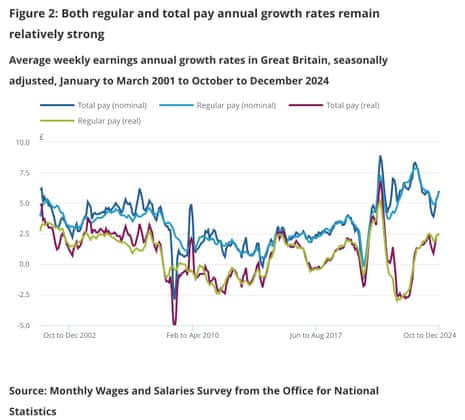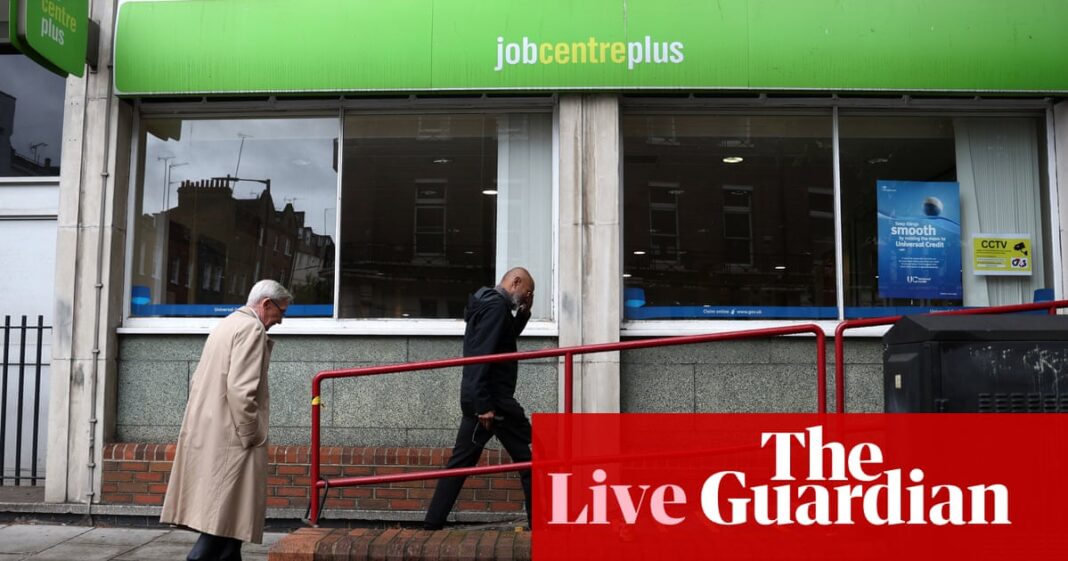UK pay growth picks up
Good morning, and welcome to our rolling coverage of economics, the financial markets and the world economy.
UK pay growth has accelerated at the end of last year, bringing relief to workers and a headache for the Bank of England
The latest employment data, just released, shows that total pay rose by 6% per year in the October-December quarter – up from 4.4% in July-September, and a little faster than City economists expected.
Regular pay (excluding bonuses) rose by 5.9% in the Oct-Dec quarter, down from 4.9% in the previous three months.
These increases mean earnings continued to rise faster than inflation, meaning real wages rose. Adjusted for the CPI inflation rate, both real regular and total pay rose by 3.4% on the year.
That is likely to cause some concerns at the BoE – the Bank cut interest rates earlier this month, but some policymakers remain worried that inflationary pressures are still bubbling.

ONS director of economic statistics Liz McKeown says:
“Growth in pay, excluding bonuses, rose for a third consecutive time, with increases seen in both the private and public sector. After taking account of inflation, real pay growth also increased slightly.
Today’s jobs report also shows that both employment and unemployment rose in the quarter, while the number of people out of the labour market (economically inactive) dipped.
Here’s the details:
-
The UK employment rate for people aged 16 to 64 years was estimated at 74.9% in October to December 2024. This is above estimates of a year ago, and up in the latest quarter.
-
The UK unemployment rate for people aged 16 years and over was estimated at 4.4% in October to December 2024. This is above estimates of a year ago, and up in the latest quarter.
-
The UK economic inactivity rate for people aged 16 to 64 years was estimated at 21.5% in October to December 2024. This is below estimates of a year ago, and down in the latest quarter.
-
The UK Claimant Count for January 2025 increased on the month and is up on the year, at 1.750 million.
The agenda
-
7am GMT: UK labour market force report
-
9.30am GMT: ONS Productivity flash estimate and overview for the UK
-
Morning: Court ruling on Thames Water debt deal
Key events
Bank of England expected to take “gradual and careful” approach to rate cuts
The increase in UK wage growth in the last quarter is likely to deter the Bank of England from rapid cuts to interest rates this year.
Currently, the City expect two more quarter-point cuts to Bank rate by the end of the year, to 4%, following the reduction from 4.75% to 4.5% earlier this month.
But with total wages rising at 6% in the last quarter – three times as fast as the BoE’s inflation target – policymakers may be cautious.
Currently, the money markets say there’s a 78% chance that the Bank leaves rates on hold next month. A cut isn’t fully priced in until June – earlier this month it was May.
And the third cut of the year might not happen until September or even November’s meeting – rather than coming as early as August, as had been pencilled in recently.
Today’s data illustrates the challenge facing the Bank’s Monetary Policy Committee (MPC), says Matt Swannell, chief economic advisor to the EY ITEM Club, adding:
Having weakened over the course of 2024, there were no clear signs that the prospects for the jobs market are improving. At the same time, pay growth is still too high to get inflation back to the 2% target, and firms will soon face the extra cost burden of higher employer National Insurance Contributions (NICs).
Faced with this trade-off, we think the MPC will continue to lower Bank Rate gradually, with the next cut likely to come in May, and that the Bank of England will use this extra time to gauge just how sticky inflation will be.
But some experts argue that the Bank will cut rates four times this year – not just the three expected by the markets.
Thomas Pugh, economist at leading audit, tax and consulting firm RSM UK, says:
“The further rise in pay growth, combined with signs of a gradual easing in employment rather than a collapse, will keep the Bank of England on its “gradual and careful” rate cutting path. We still expect the MPC to cut rates at every other meeting this year, which would leave interest rates at 3.75% by the end of the year.
ING: UK jobs market stable despite growing pessimism
The UK labour market looks better than some of the gloom swirling about the economy, argues James Smith, developed markets economist at ING.
He tells clients:
An air of pessimism is befalling the UK jobs market right now, ahead of a sizeable increase in employer’s National Insurance (social security) in April.
The surveys on hiring are turning increasingly sour and there’s growing talk of redundancies as firms grapple with the combined hit of tax hikes and a near-7% increase in the National Living Wage. Bank of England policymaker Catherine Mann, explaining her vote for a bumper rate cut this month, spoke of “non-linear” falls in employment.
Despite that gloomy backdrop, the hard numbers on the jobs market currently don’t look so bad. Unemployment is broadly stable, though remember this data is highly dubious right now. But even the supposedly more reliable payroll-based numbers were more stable in January. The steady 1% fall in those numbers across 2024, once government-heavy sectors are excluded, stalled last month. More importantly, there’s no discernible increase in redundancies. So-called HR1 notifications, which companies are required to submit to the government if they are planning layoffs, are bouncing around their lows. The major question is whether that changes as the tax and Living Wage changes come through in the second quarter.
That’s not to say the jobs market hasn’t cooled materially, though. Vacancies have fallen steadily over the past couple of years, back to pre-Covid levels. On a sector basis, vacancy rates in the likes of retail and hospitality are well below the levels seen in 2019. And that makes it all the more puzzling that wage growth is still up around 6%.
Work and Pensions Secretary Liz Kendall is pledging to bring down the UK’s economic inactivity levels, saying:
“Since July, wages have continued to grow at pace, putting vital money back in people’s pockets as we work to make work pay and improve living standards for all.
“But these figures also show that too many people are being locked out of work and denied that chance, including those sick and disabled.
“Instead of writing people off and labelling them, we must step up our support.”
Consultation on major overhaul of Britain’s railways launching today

Gwyn Topham
A new rail watchdog will give passengers a voice and hold the railway to account, the government has promised, as it launched a public consultation ahead of legislation to create Great British Railways.
Ministers intend it to have a beefed-up role in the future nationalised railway, with train operators having an obligation to consult the watchdog – which will replace the current Transport Focus – ahead of major decisions affecting passengers.
The new body will be tasked with setting standards for passengers on journey information and assistance, publishing reports on poor service and potentially referring instances to the railway regulator for enforcement action.
The eight-week consultation will also lay out plans to unite train and track operations and give devolved leaders more of a say on services.
Transport secretary Heidi Alexander said it was a “landmark reform [to] sweep away decades of failure, adding:
“We’re giving passengers a powerful voice with a new watchdog dedicated to addressing their biggest concerns, building railways people can trust, improving our services and boosting the economy in the process.”
Laura Shoaf, chair of shadow GBR, said:
“GBR will fundamentally change our railways, delivering growth, connections and opportunities across the country. The plans set out today will mean a better railway for everyone that uses it, allowing industry to work closer together, putting passengers and customers first and providing better value for money for taxpayers.
Campaigners welcomed the consultation. “Giving the public a say in what rail reform should look like is key to making it a success,” said Paul Tuohy, chief executive of Campaign for Better Transport.
He said they backed the creation of a new watchdog, adding:
“We will need to see what this means in practice, and whether this new watchdog will have any teeth to hold GBR to account when it needs to.”.
IoD: Continued decline in job vacancies highlights need for government action
The latest drop in job vacancies (see earlier post) shows that businesses lack confidence to hire new staff, the Institute of Directors warns this morning.
Alex Hall-Chen, Principal Policy Advisor for Employment at the IoD, says:
“The cumulative impact of recent employment reforms, coupled with upcoming increases to employer National Insurance Contributions and the National Living Wage, is significantly weakening the business case for hiring. Our latest data indicates that firms’ headcount expectations remain at historically low levels, comparable to those seen during the early stages of the COVID-19 pandemic in 2020.
“Immediate action is needed to address the mounting pressures on businesses and to restore confidence in the labour market. As the Employment Rights Bill approaches its Report stage, we urge the government to introduce targeted changes that will support employers and stimulate job creation. Our data shows that 41% of business leaders believe that such changes would do most to boost business confidence in 2025.”
This morning’s UK labour market report shows “continued labour market fragility” as 2024 drew to a close, argues Michael Brown, senior research strategist at Pepperstone.
He alaso agrees that the Bank of England will not be pleased to see wages rising so much faster than inflation:
Unemployment, in the three months to December, unexpectedly held steady at 4.4%, marginally below the BoE’s 4.5% forecast. These figures, though, must once again be taken with a pinch of salt, due to the ONS’ ongoing data collection, survey, and quality issues.
Meanwhile, earnings pressures intensified over the same period. Regular pay rose 5.9% YoY at the tail end of last year, the fastest pace since last April, while overall pay (inc. bonuses) rose 6.0% on an annual basis, the fastest pace since November 2023.
Such a pace of earnings growth is, clearly, incompatible with a sustainable return to the Bank of England’s 2% inflation target over the medium term.
Pay is rising rather faster in the private sector than in the public sector.
Today’s labour market report shows that regular pay in the private sector rose by 6.2% in October-December, ahead of the 4.7% increase recorded in the public sector.
Total pay (including bonuses) was 0.1 percentage point higher on both measures.
Payrolls rose in January despite budget ‘hit’
Today’s jobs report should give an insight into how the UK labour market fared after Rachel Reeves’s budget in October.
Many businesses have been griping about the chancellor’s decision to lift employers’ national insurance contributions – which could raise £22bn in extra tax – arguing it will lead to job cuts.
But today’s data estimates that the number of payrolled employees in January increased by 21,000, meaning there were 49,000 more people on company payrolls than a year ago.
That follows a 14,000 drop in December.
Vacancies fall again
Firms are continuing to cut back on vacancies, today’s jobs report shows, as the surge in job opportunities after Covid-19 lockdowns ended fades.
There were an estimated 819,000 vacancies in the UK in November 2024 to January 2025; a decrease of 9,000, or 1.1%, from August to October 2024.
ONS director of economic statistics Liz McKeown said:
“The number of employees on payroll was broadly unchanged in the last three months of the year, continuing a medium-term trend of slowing growth. The number of vacancies also continued to fall in the latest quarter, albeit more slowly, with the total number remaining a little above its pre-pandemic level.
UK pay growth picks up
Good morning, and welcome to our rolling coverage of economics, the financial markets and the world economy.
UK pay growth has accelerated at the end of last year, bringing relief to workers and a headache for the Bank of England
The latest employment data, just released, shows that total pay rose by 6% per year in the October-December quarter – up from 4.4% in July-September, and a little faster than City economists expected.
Regular pay (excluding bonuses) rose by 5.9% in the Oct-Dec quarter, down from 4.9% in the previous three months.
These increases mean earnings continued to rise faster than inflation, meaning real wages rose. Adjusted for the CPI inflation rate, both real regular and total pay rose by 3.4% on the year.
That is likely to cause some concerns at the BoE – the Bank cut interest rates earlier this month, but some policymakers remain worried that inflationary pressures are still bubbling.
ONS director of economic statistics Liz McKeown says:
“Growth in pay, excluding bonuses, rose for a third consecutive time, with increases seen in both the private and public sector. After taking account of inflation, real pay growth also increased slightly.
Today’s jobs report also shows that both employment and unemployment rose in the quarter, while the number of people out of the labour market (economically inactive) dipped.
Here’s the details:
-
The UK employment rate for people aged 16 to 64 years was estimated at 74.9% in October to December 2024. This is above estimates of a year ago, and up in the latest quarter.
-
The UK unemployment rate for people aged 16 years and over was estimated at 4.4% in October to December 2024. This is above estimates of a year ago, and up in the latest quarter.
-
The UK economic inactivity rate for people aged 16 to 64 years was estimated at 21.5% in October to December 2024. This is below estimates of a year ago, and down in the latest quarter.
-
The UK Claimant Count for January 2025 increased on the month and is up on the year, at 1.750 million.
The agenda
-
7am GMT: UK labour market force report
-
9.30am GMT: ONS Productivity flash estimate and overview for the UK
-
Morning: Court ruling on Thames Water debt deal


